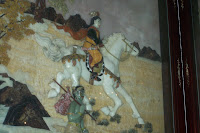
We were up early, 5:30 am, packed, ate a good breakfast and ready to leave for the airport at 6:30 am to fly on the Chinese airline to our next city, Xi'an. (see on)We were met by Susan

and our new red bus. Susan looked very young, but was 25 years old. She had a bright personality and bubbled with enthusiasm.
Xi'an was the starting point of the "silk road", and was the largest and wealthiest city in the world. It was the capital of China and home for 13 emperors before the capital was moved to Beijing. There is evidence of human beings 1,000,000 years ago. Hunting, fishing, agriculture, pottery evidence go back 6000 years ago.

The city was very clean. Women with straw brooms were continuously working to get rid of the dust. Susan said that dust storms often came to Xi'an. The streets were watered down every day to keep the dust down. The air, however, was another matter. There was a haze everywhere as we looked out the airplane window and

again in the bus.
Our first stop in Xi'an was the Wild Goose Pagoda. It was built in 648 AD because the esteemed Buddha master, Xuan Zang, had seen a flock of geese flying over a temple. One of the geese fell to the ground. Instead of eating the goose, the monks buried it. He honored that day by building the Wild Goose Pagoda. Xuan Zang had traveled to India where he studied for 14 years and brought back bundles of scriptures. The Pagoda was protection for these scriptures and home for 300 monks who studied with him.With elaborate carvings over each doorway, the Pagoda rises seven stories and 200 feet into the air. It is now leaning one meter to the west and has been emptied of its contents. Buddha's Hall was decorated with white jade. Buddhas were on the walls, and the ceilings were decorated with gold Buddhas. In an addition to the temple, dating to only 50 years ago, was a three-wall carved decoration in many colors of jade telling the

story of

Buddha's birth, travels to India, and his enlightenment. I was glad we had listened to the information about jade before this visit. I could appreciate the carvings so much more.

The outside grounds around the Pagoda were quite beautiful with carved white marble steps, and walls. Also the statues,


the trees and grounds provided a very spiritual environment.

Back at the bus, we were visited again by the street vendors. We had learned by this time how to handle them by saying "no" several times, and then begin to walk away. That way we got their lowest price.

Lunch was next, and we found out why the people of Xi'an were called "the dumpling eaters."
 On our way to the Xi'an City Wall, we were treated to a look at the downtown. After 1980, it became illegal to have more than one child. If a second child comes to the family, taxes increase and they
On our way to the Xi'an City Wall, we were treated to a look at the downtown. After 1980, it became illegal to have more than one child. If a second child comes to the family, taxes increase and they  can even lose their home and job! Now, however, the government sees that there are not enough girls for the young men to marry, so if the first child is a girl, they may have a second child. Also, if both the husband and wife come from a one child family, they can have 2 children.
can even lose their home and job! Now, however, the government sees that there are not enough girls for the young men to marry, so if the first child is a girl, they may have a second child. Also, if both the husband and wife come from a one child family, they can have 2 children. 
 We had a lecture on Feng Shui and we could see the way homes and businesses use that design to keep energy flowing
We had a lecture on Feng Shui and we could see the way homes and businesses use that design to keep energy flowing  throughout the buildings.Very old carts,bells, and towers were out for visitors to see.
throughout the buildings.Very old carts,bells, and towers were out for visitors to see.
 Even the wastecans were decorative... with dragons, of course.
Even the wastecans were decorative... with dragons, of course.  The Xi'an City Wall will always be one of my favorite memories. It is the best preserved city wall in the world. It is wide and smooth and provides a look at the old city and the new city.
The Xi'an City Wall will always be one of my favorite memories. It is the best preserved city wall in the world. It is wide and smooth and provides a look at the old city and the new city.







 Buddha's birth, travels to India, and his enlightenment. I was glad we had listened to the information about jade before this visit. I could appreciate the carvings so much more.
Buddha's birth, travels to India, and his enlightenment. I was glad we had listened to the information about jade before this visit. I could appreciate the carvings so much more.

 the trees and grounds provided a very spiritual environment.
the trees and grounds provided a very spiritual environment.

